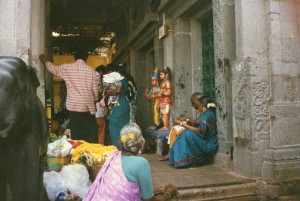Many things kept getting bigger in Ancient India. Narratives became vast to extents that have disoriented Westerners. I overheard a woman in Oxford’s Ashmolean Museum say, “I don’t understand Indian religion. There are too many gods.”
As Jesus’ life took a central place in Western thought, Indian’s developed other ideas of how divinity becomes embodied.
Jesus is the only son of God. He lived and died once, for our salvation. The Old Testament prefigures The New Testament, which details Jesus’ life. Jesus and the four Gospels that bring the good news of his life fulfill God’s glory and love. The ultimate expression of a perfect god’s power and love is to father a son who saves the people He created from their own sins.
This linear view of time became central in the West, as Indian concepts of time were expanding into larger and larger repeating cycles. At the same time, Indians developed a massive corpus of literature around ideas of gods incarnating many times.
For example, in the Vedas, Vishnu was a solar god, who was less honored than the main Vedic deities, like Indra and Agni.
But in the 1st millennium CE, a huge body of texts called the Puranas detailed Vishnu’s 10 incarnations in a colorful variety of stories:
1. Matsya: A fish who saved the first man, Manu, from drowning.
2. Kurma: A tortoise, who allowed himself to be used as a pivot when the gods and asuras (demons) churned the ocean. This was a key scene on the east wall at Angkor Wat.
3. Varaha: A boar who saved the earth from the ocean, which was engulfing it.
4. Narasimha: A half man, half lion hero who killed a demon called Hiranyakashipu. A scene from this tale was carved in the Khmer temple Banteay Srei.
5. Vamana: A dwarf who conquered King Bali by getting him to agree to let him rule the area he could stride in three steps. He grew to encompass the whole universe.
6. Parashurama: A hero who killed a thousand-armed king.
7. Rama: The hero in the Ramayana.
8. Krishna: Arjuna’s chariot driver in the Bhagavad Gita, who teaches him about the universe and the way to salvation.
9. The Buddha. The great teacher became absorbed in India’s massive Hindu literary tradition.
10. Kalki. The future incarnation of Vishnu, at the end of the current temporal cycle (yuga).
Indians elaborated ideas of incarnations of Vishnu even more. Some Puranas listed dozens. Shiva and the Buddha also took on many incarnations, and stories about their past lives proliferated.
This very different idea than Jesus’ once-and-for-all life was reinforced by many factors:
1. India’s natural landscape, which encourages ideas of things as larger than life.
2. The Rg Veda’s traditions, which encouraged people to see the universe in terms of flows of cosmic energies, rather than the distinct events, characters and places that the West has emphasized.
3. India’s political landscape, which was usually fragmented into many states. The land’s diverse regions had their own myths about gods and heroes. This huge variety of stories amalgamated into a vast field in which a character could transform into many existences.
4. Older ideas of life as a vast chain of existences determined by one’s karma (the sum of one’s actions and mental impressions).
5. Views of time as enormously long cycles.
6. Architecture. Temples expressed a vast universe of many temporal periods, deities, and levels of metaphysical existence.
7. The tremendous amount of ritual activity that developed for each incarnation.
So Indian views of reality as a vast field that dwarfs any single existence developed from many currents. Their large number converged into a different idea of how divinity incarnates than the West’s emphasis on Jesus. India’s ideas of a huge universe and many gods may baffle some of the good people of Oxford, but they’re very ancient. They were established in a cultural landscape with many dimensions.
The British ruled India, and gave it many technologies. But understanding it takes imagination. Please keep reading future posts–we have a lot more flying to do.




{ 2 comments }
As demonstrated in the atomic bomb, the Asuras are in favor of splitting things and blowing them into pieces.
I heard that Robert Oppenheimer quoted a line from the Bhagavad Gita when one of the first A-boms eploded. Krishna said something like, “I am the destroyer of all things.” Let’s hope our political leaders gain wisdom about the unity of life to balance their ability to destroy it.
Comments on this entry are closed.